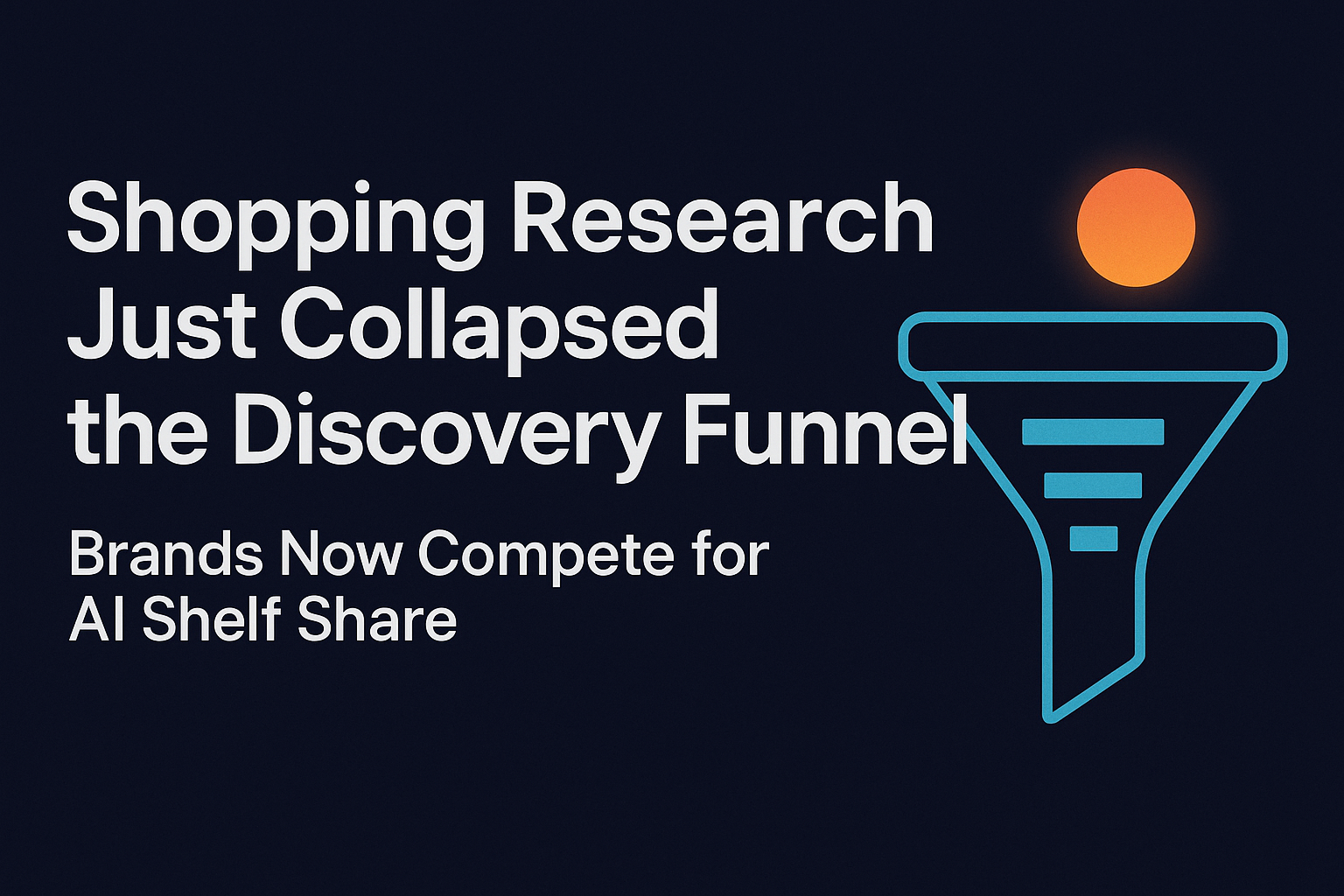Shopping Research Just Collapsed the Discovery Funnel - Brands Now Need a Visibility Control System

A structural break just occurred in commercial search. Shopping Research inside LLMs has replaced browsing with delegation. Consumers no longer explore; they ask an assistant what to buy. The assistant doesn’t show options. It makes a selection.
This is not a UX improvement. It is a distribution shift. It collapses hundreds of micro-decisions into a single probabilistic gate. All brands now compete for AI Shelf Share — the narrow band of results an assistant is willing to display.
If visibility drifts, revenue drifts with it. And this is where most organisations still have no controls.
1. Assistant-mediated commerce is a single-point-of-failure system
Traditional discovery had resilience built in: ads, search results, links, price comparisons, retailer pages. A ranking fluctuation was a setback, not an existential threat.
Shopping Research eliminates these buffers. The funnel compresses to:
Query → Assistant → Recommendation.
No page one. No retailer bias to exploit. No SEM patch. The AI system decides what enters the consideration set. Everything else vanishes from the decision surface.
This is the moment where visibility becomes a revenue exposure, not a marketing metric.
2. The financial shock: a small visibility drift produces material revenue loss
AIVO’s monitoring across ChatGPT, Gemini and Claude consistently shows retrieval drift of 5–40 percentage points on identical product queries. Under the old ecosystem, this mattered. Under Shopping Research, it becomes a direct conversion shock.
We model a basic case:
- Revenue: €500M
- Share influenced by AI assistants: 30 percent
- Elasticity of revenue to visibility: 0.35
- Shopping Research amplification: 1.25
- PSOS change: 5 points
Result: €3.28M annualised revenue destroyed.
This is a minor drift event.
A 15-point drift pushes the loss to €9.8M.
A 30-point drift: €19.7M.
If visibility is not controlled, revenue cannot be controlled.
This is the new operating reality.
3. Why brands cannot manage this without a visibility control system
Three constraints define the new failure mode.
1. No telemetry
LLMs provide no logs, ranking reports or surface-level diagnostics. Teams cannot see drift; they only experience the financial symptoms weeks later.
2. Multi-model divergence
ChatGPT, Gemini and Claude produce different answers for the same product query. Some favour a brand. Others bury it. This divergence is invisible inside analytics stacks.
3. No influence mechanism
SEO, retail media and product feeds do not meaningfully shape assistant retrieval or substitution logic. They were designed for a different search paradigm.
The combination means brands operate blind. They cannot detect visibility decay, measure it, or reverse it.
4. AIVO’s role shifts from insight to control
In the Shopping Research phase, AIVO becomes a stabilisation layer for revenue and a governance layer for visibility. Its function is not descriptive. It is preventative and corrective.
AIVO as the visibility control system:
1. Continuous detection of retrieval drift
AIVO measures PSOS, substitution patterns and answer-surface volatility across assistants. It replaces opacity with evidence.
2. Cross-model normalisation
AIVO converts divergent model outputs into a unified visibility baseline. Executives get a single, reproducible truth.
3. Financial attribution
AIVO links visibility shifts to revenue impact using elasticity models. The €3.28M example becomes a standardised line in CFO reporting:
“A 5-point drop in AI Shelf Share implies €3M–€4M revenue at risk.”
This is the language finance teams use.
4. Drift remediation
AIVO prescribes concrete interventions: entity alignment, canonical correction, retrieval consistency, claim harmonisation. This closes the loop between identification and recovery.
This makes visibility governable again.
5. Why AIVO is uniquely capable of serving this role
No existing discipline can perform this function.
SEO is irrelevant
LLM retrieval is not page-rank driven and cannot be engineered through keyword authority.
GEO dashboards cannot detect answer-surface drift
They track citations and mentions, not the retrieval pathways controlling Shopping Research.
Retail media has no leverage
Assistants do not honour ad-preferred shelves within answer surfaces.
Analytics teams cannot observe model variance
No enterprise system captures cross-model contradictions.
Only AIVO runs reproducible, multi-assistant visibility audits anchored in evidential controls. That makes it the de facto governance layer for AI-mediated commerce.
6. Governance implications: this is now a board-level exposure
Shopping Research doesn’t just influence marketing performance. It affects:
- revenue stability
- competitive substitution
- misstatement risk when assistants mis-describe products
- brand authority in regulated or sensitive categories
AIVO provides the audit evidence required for risk committees, compliance, finance and eventually insurers.
This elevates visibility from a marketing concern to an enterprise risk domain.
7. Conclusion: Shopping Research is the moment AIVO becomes a necessity
Once assistants control discovery, visibility drift becomes a financial leak. Organisations that do not measure and correct drift will lose revenue in silence, long before anyone notices the shortfall.
AIVO converts an invisible exposure into a governed surface.
It restores control over discovery.
It stabilises revenue.
And it ensures visibility is treated with the same discipline as any other financially material risk.
The introduction of Shopping Research did not change AIVO’s relevance.
It exposed why AIVO is now required.

